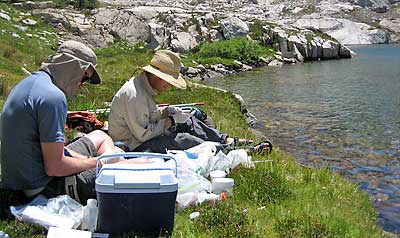Frog-killing fungus
 When we get to our fungi lecture I won't have more than a few minutes to talk about a strange group of fungi the Chitridiomycota - or the Chytrid fungi. Not included in the Fungi group until recently they are mostly detritivores, living on dead material, but at least one species is pathogenic. The waterborne fungus, Batrachochytrium dendrobatidis, attacks many species of amphibians and is at least partially responsible for a global decline of amphibians.
When we get to our fungi lecture I won't have more than a few minutes to talk about a strange group of fungi the Chitridiomycota - or the Chytrid fungi. Not included in the Fungi group until recently they are mostly detritivores, living on dead material, but at least one species is pathogenic. The waterborne fungus, Batrachochytrium dendrobatidis, attacks many species of amphibians and is at least partially responsible for a global decline of amphibians.Work carried out at UC Berkeley and published in PNAS next week now suggests that the fungus may end up playing the bigger role in the frog's demise than previously thought because of the pathogen's ability to spread over long distances and possibly persist in the environment as a consequence of sexual reproduction. A study of the genetics of the fungus provided the first evidence of genetic recombination in B. dendrobatidis, which results in multiple, related genotypes and suggests that sexual reproduction is occurring - even though spores have not been discovered.
This work was carried out in the Briggs lab in Integrative Biology in association with the Taylor lab in Plant and Microbial Biology and is part of a larger project on chytridiomycosis (the disease caused by B. dendrobatidis) and the mountain yellow-legged frog led by Cheryl Briggs, UC Berkeley associate professor of integrative biology.
This time last year: CNR Smorgasbord
Labels: Conservation, Disease, Fungi, Research Reports
0 Comments:
Post a Comment
<< Home